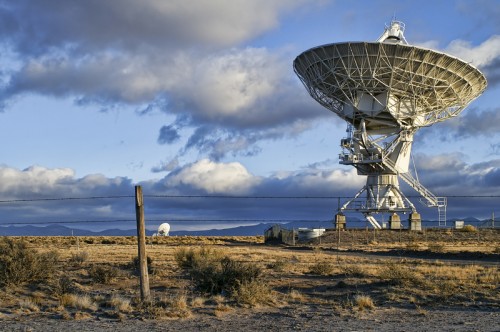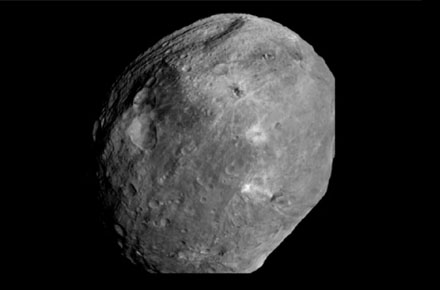SETI Allows You to Help Search for Aliens


“Somewhere, something incredible is waiting to be known.”
Dr. Carl Sagan
The question of whether or not we are alone in the universe has plagued humanity for ages. With the advance of science and space exploration, the possibility of finding life occurring elsewhere in the universe is becoming more and more likely. However, the gulf between simple life, such as bacteria, and “intelligent” life, which could possibly communicate with the Earth, remains great.
At this point in time, no one can say for certain if there is intelligent life out there, but many bright and intelligent people have decided to assist in the search for it. SETI, or the search for extraterrestrial life, is a field of study that focuses on the deep-seated desire of humanity to know if we truly are alone in the universe. There are two large organizations that perform the majority of work done in this field, the SETI Institute and SETI@home.
The SETI Institute
The “SETI” that is often associated with astronomer Carl Sagan is actually the SETI Institute. It is comprised of three centers which work together on projects sponsored primarily by institutes such as NASA and occasionally private donors.
The SETI Institute conducted its searches of the night sky using a telescope array known as the “Allen Telescope Array,” which is run by the University of California, Berkeley. The Allen Telescope Array is a group of 42 radio dishes that would coordinate to scan an area of the sky while hoping to capture radio waves originating from intelligent life on distant worlds.
As a non-profit organization, the SETI Institute is highly vulnerable to funding shortfalls. In April 2011, its main form of search, the Allen Telescope Array, went dark due to funding cuts at the University of California, Berkeley. These funding cuts resulted in the ATA being put into “hibernation” mode until the funding shortfall can be closed.
While this is a major setback for the SETI Institute, it is not the end of the road for the organization. Many of the organizations other programs will continue without interruption. The SETI Institute is actively lobbying for support and donations and they hope to have the ATA back online before the end of 2011.
When it comes to capturing and analyzing data, the SETI Institute does all of its work in-house. It does not divvy out work to amateurs for assistance. This decision was made early on, and provided a way for the institute to retain tight control over any potential findings. Belief was that by keeping the work in-house it would be easier for the organization to protect its integrity and ensure all findings were properly vetted and verified.
For those who truly wish to get their hands dirty and actively participate in the search, SETI@home might be a better choice to support.
SETI@Home
SETI@home also has its roots at the University of California, but is a completely separate organization from the SETI Institute. Unlike the SETI Institute, SETI@home relies heavily on the use of volunteers and allows the general public to take part in its search.
SETI@home is hosted by the Space Sciences Lab at the University of California, Berkeley and distributes data to volunteers via the internet. The data is then analyzed by those computers when the machines are not in active use by their owners.
SETI@home arose with the goal of doing valid and useful scientific work while proving the viability and practicality of the new concept of “volunteer computing.” While the merits of the “usefulness” of the work done by SETI@home might be open to debate, there is no question that the organization has been an outstanding success in proving the concept of volunteer computing.
The Rise of Volunteer Computing
The term “volunteer computing” does not mean computers sign up, suit up and then ship out for a destination to do volunteer work. Instead, volunteer computing is a method that uses the internet to distribute a workload of data across a vast network of computers, using their computing power to analyzing enormous amounts of data. This method, called distributed computing, allows masses of lower powered computers to combine and complete tasks that once could only be accomplished by using supercomputers.
SETI@home uses a network infrastructure known as “BOINC,” which is an acronym for The Berkeley Open Infrastructure for Network Computing. BOINC was originally constructed with SETI@home in mind and is now a platform used by numerous scientific and medical fields for a wide variety of distributed computing projects. The success of this platform is due to the number of active volunteers it has attracted worldwide.
SETI@home was the first successful venture into this field for BOINC and has been an astounding success. As of March 2011, the processing power of BOINC officially topped that of the fastest supercomputer system in the world, China’s Tianhe-l. BOINC averages about 525,000 active volunteer computers worldwide and currently has the processing power of over 5.549 petaFLOPS.
The SETI@home Method
When SETI@Home is granted use of a telescope, the scope is then used to search the sky for radio waves and records the data gathered. The data is then delivered to SETI@home which divides it into small data units which are then transmitted to the volunteer PCs for analysis. Yearly, SETI@home typically acquires about 60 terabytes of data for analysis.
SETI@home Data Sources

SETI@home uses data gathered primarily from the Arecibo radio telescope located in Puerto Rico. Unlike the ATA, this telescope is not solely used for SETI purposes and is not funded by the University of California. The Allen Telescope Array shutdown did not affect SETI@home because this organization did not directly receive data from that array.
Additionally, SETI@home recently acquired usage of the Robert C Byrd Green Bank Telescope and was able to gather 24 hours of data from the powerful telescope. The data was gathered while pointing the scope at planets discovered by NASA’s Kepler telescope and that appear to be prime candidates for the development of life. The observation produced about 60 terabytes of data for SETI@home, which is roughly the same amount of data gathered from Arecibo telescope in a year.
How SETI@home Works
People can volunteer their computer’s processing power using an application that will download and analyze available data units from SETI@home when the computer is not in use. The program displays the SETI analysis as the screensaver, and volunteers can watch the analysis as it occurs.
The Volunteer Experience
The SETI@home program is designed to be unobtrusive, but users have the option of changing how much resources and computing power the program has access to. Some users opt to give SETI@home full control over resources for specific periods of time, while others let it run in the background using only low levels of computing power.
While the screensaver is running, the user sees a display of the activity being performed by the program. They are shown data information, user information and analysis information.
The data information box displays the specifics of the data unit being processed. It will display the time it was recorded, the sky coordinates, the telescope that gathered the information and even the frequency of the signal being analyzed.
The user information box displays information specific to the computer the program is run on. It includes user name, total data units processed by the computer and the total amount of time spent computing.
The analysis box is where the action takes place. This box will show exactly what the program is actively doing, from connecting to the server to actually analyzing data. It displays a graph with a progress bar that details the data being analyzed and the time remaining on a specific data unit. If the program detects signal pulses, it will then display another graph detailing the pulses and the frequency they were found at.
Has SETI Ever Found Anything?
While a verifiably “intelligent” extraterrestrial data signal has yet to be found, there have been some abnormalities that have occurred over the years in this field. Since astronomers first started listening to the skies above, there have been two verified false alarms and two true anomalies discovered.
CTA-102
In 1963, astronomer Nikolai Kardashev suggested that an unidentified radio wave that had been detected was originating from an extraterrestrial civilization.
While the radio wave was verified by multiple sources, it was not the result of an ET civilization.
Instead, this false alarm was caused by a variety of quasar, a large and extremely powerful celestial object that emits energy and radio frequencies.
While a quasar is still mysterious to science, it is a naturally occurring phenomenon in the universe and not an example of intelligent communication.
LGM-1
LGM-1, or little green men 1, is the name given to a radio signal that was detected by a UK observatory in 1967. LGM-1 had a regular transmission rate and was virtually perfect in its regularity.
These traits led to speculation that it could be a signal beacon or communication stream with an intelligent origin. Further analysis and study proved this theory wrong.
Instead of ET, scientists had stumbled upon the radio emissions from a pulsar star named CP1919.
While this was the first recognized pulsar star, it was naturally occurring and not intelligent in origin.
The Wow! Signal
On August 15, 1977, Dr. Jerry Ehman spotted a signal with traits that were expected of intelligent origins. On a print-out of the data, Dr. Ehman circled the signal in red and wrote “Wow!” next to it in red ink.
The signal displayed the signature that scientists expected from intelligent life and lasted for the entire 72 seconds the telescope was aimed at the area.
While the signal has never been found again, even with dedicated searching in the area it was detected, debate still lingers over what exactly the signal could have been.
Theories range from earth signals bouncing off space debris to the signal being transmitted by an extraterrestrial craft while in flight.
Radio Source SHGb02+14a
In March 2003, SETI@home discovered an abnormal signal originating from a source between the constellations of Aries and Pisces, in an area of the sky where there are no stars within 1000 light years.
There are several odd components to this unknown signal. First, the signal itself is extremely weak. Then, the signal also has a very rapid drift, meaning the point it is coming from appears to be moving quickly.
If the signal came from a planet, that planet would have to be orbiting around its star nearly 40 times quicker than the Earth orbits the sun.
While the source was successfully observed three times, SETI@home has stated that it is not likely a signal from intelligent life.
Likely explanations for the signal include cosmic noise, faulty technology, a distant pulsar star or just random space noise.
The thought of other intelligent life existing in the universe is enticing, yet frightening at the same time. The discovery of extraterrestrial intelligence would shake the foundations of world religions and drastically change human relations at all levels. There are also doubts as to whether or not intelligent life would actually be friendly, raising the question of whether or not we should be trying to avoid detection ourselves.
Regardless of what may be awaiting humanity in the depths of space, the insatiable nature of human curiosity continues to drive and motivate the search to discover whatever may be awaiting us.
SETI provides a way for anyone to aid in this search and provides even amateurs an outlet for their desire to simply “know.”










